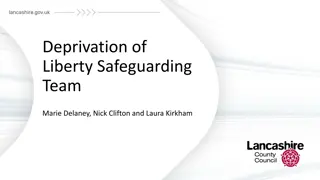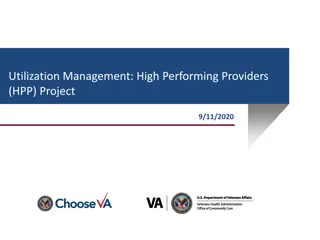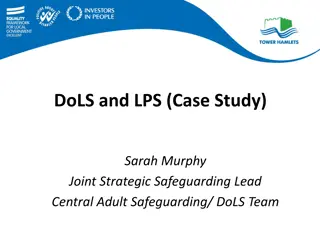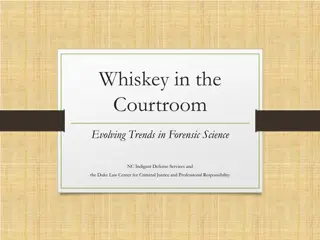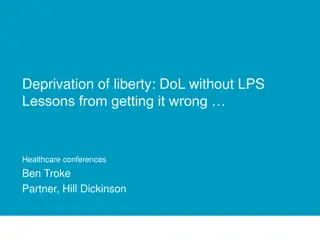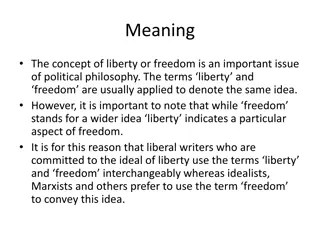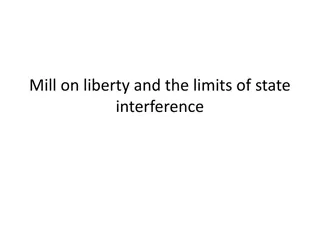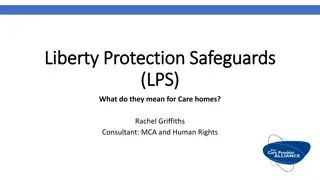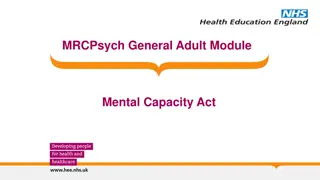Understanding Deprivation of Liberty Training for Care Providers
Exploring the key principles and legal framework surrounding deprivation of liberty in care settings, including the rights of individuals, procedures for lawful detention, and factors to consider in determining deprivation. The content delves into the evolving definition of deprivation, subjective and objective aspects, and the Acid Test as a benchmark.
Download Presentation

Please find below an Image/Link to download the presentation.
The content on the website is provided AS IS for your information and personal use only. It may not be sold, licensed, or shared on other websites without obtaining consent from the author. Download presentation by click this link. If you encounter any issues during the download, it is possible that the publisher has removed the file from their server.
E N D
Presentation Transcript
Deprivation of Liberty Training For Care Providers Gary Underhill spearmanconsultancy@gmail.com 07933 393 885 Spearman Consultancy 21-5-2014 1
Deprivation of liberty Background Art 5(1) ECHR Everyone has the right to liberty. No (person of unsound mind) shall be deprived of liberty without a procedure prescribed by law Art 5 (4) Everyone deprived of their liberty shall be entitled to take proceedings to quickly decide the lawfulness of the detention Bournewood case - ECJ found UK to be non compliant with Art 5 hence DoL s/guards Spearman Consultancy 21-5-2014 2
When is there a deprivation? No statutory definition references to DOL in the Act have the same meaning as in Art 5 Therefore the definition is evolving and practitioners must look at case law of both European & UK courts Spearman Consultancy 21-5-2014 3
Lining up your ducks Subjective Objective State Responsibility Spearman Consultancy 21-5-2014 4
Weighing deprivation Objective A Multi-factorial Approach Look at P s whole situation & context Confinement Objections or compliance Extent of control Carers are they refused contact, discharge? Relative normality of life Where living Signs of normality Purpose of the restrictions Whether P has somewhere else they could go Spearman Consultancy 21-5-2014 5
An easier way? Objective Relevant comparator But subjective & no consistency Means incapacitated people have less rights Spearman Consultancy 21-5-2014 6
The Acid Test Supreme Court majority discovered in the case law that there was indeed a line of reasoning or litmus test running through the jurisprudence: Continuous Supervision & Control & Not free to leave Spearman Consultancy 21-5-2014 7
Reasoning Universality of Human Rights - so definition of deprivation not related to capacity or disability Issue of DoL is separate to that of BI (instead of a view on BI affecting whether restrictions are DoL) No longer relevant: Presence or absence of objections Relevant normality of placement Reason or purpose of placement Relevant comparator is a capacitated person of same age Spearman Consultancy 21-5-2014 8
Debates about interpretation Concrete situation still relevant, but now some clear objective guidance rather than a lucky dip! CS+C commonalities from P, Mig & Meg 24/7 Not being allowed out without supervision Control over contact; Control over activities Where does the sub 24/7 care DoL lie? Not free to leave Likely means freedom to leave permanently Is frequency away from care setting relevant? Spearman Consultancy 21-5-2014 9
Some Implications Lots more DoLS cases especially 39D Dementia Care homes ITU patients More sectioned patients Residence requirements NFTL e.g. g/ship Supported Living placements P supported in own homes Spearman Consultancy 21-5-2014 10
Finally If in doubt apply for the safeguards Watch for forthcoming guidance Spearman Consultancy 21-5-2014 11



